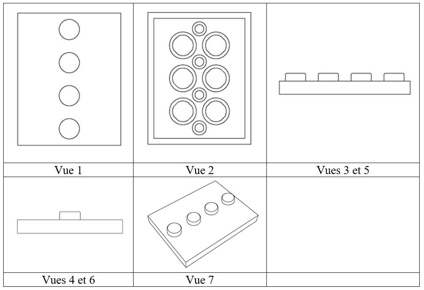T-515/19: Lego’s brick design remains valid
The General Court recently had to consider (in case T-515/19) whether Lego could use the defence of Article 8(3) of the Community Design Regulation (CDR), which exempts modular products from the general “must fit” exclusion from design protection under Article 8(2), and the relationship between the various exceptions of Article 8 in general.
Facts
Lego is, among other things, owner of the following Registered Community Design:

A motion for declaration of invalidity was filed and based on the assumption that the all the features of the design are solely dictated by the technical function of the product and therefore excluded from protection.
The EUIPO’s Cancellation Division rejected the invalidity application, but the EUIPO’s Board of appeal then declared the design invalid.
The Board of Appeal made an assessment of what it considered to be the six features of the Lego brick and found all of them were dictated solely by the technical function of the brick (that is, the assembly with, and disassembly from, other bricks in the set).
GC decision
The General Court annulled the Board of Appeal decision stating the decision contained two mistakes.
First of all, the Board of Appeal did not take into account all of the features of the Lego brick when conducting the functionality test, but only the following:
- the row of studs on the upper face of the brick;
- the row of smaller circles on the lower face of the brick;
- the two rows of bigger circles on the lower face of the brick;
- the rectangular shape of the brick;
- the thickness of the walls of the brick; and
- the cylindrical shape of the studs.
The General Court confirmed Lego’s arguments that there are other features such as the smooth surface on the upper face of the design, which should at least be considered.
Second, the Board of Appeal also did not correctly examine if the “modular system” exception of Article 8(3) was applicable in this case, as it might literally and explicitly only be applicable to cases of “must fit” parts mentioned in Article 8(2). In this context, the General Court first states that there may be certain overlap and interplay between Article 8(1) dealing with functionality of a product (connection and disconnection of that product) and Article 8(2) regarding “must fit” parts (namely features of interconnection). As a result, there may be cases where one feature could possibly fall under both provisions. In such a situation it is questionable if the exception of Article 8(3) regarding “modular systems” would then apply with respect to both protection exclusion scenarios.
The General Court affirms this question with reference to Recital 11 CDR and a number of formal arguments. It basically said there might be potential for injustice if the courts were to allow invalidity applicants to tactically base their attack only on the functionality exclusion of Article 8(1) (and not plead the “must fit” exclusion of Article 8(2) even where they would be equally applicable) solely in order to prevent the design owner from relying on the “modular system” exception of Article 8(3). Therefore, the General Court allowed the exemption to apply irrespective of which cancellation ground was chosen.
Outlook
Lego’s design is not totally yet safe as the Board of Appeal will have to conduct a new examination in line with the General Court’s comments. However, the outcome will likely not change and Lego’s brick may continue to enjoy protection as the smooth surface on the upper face of the design is likely not solely dictated by the technical function of the product.
Case details at a glance
Jurisdiction: European Union
Decision level: General Court
Parties: Lego A/S (applicant) v EUIPO (defendant)
Date: 24 March 2021
Citation: T‑515/19
Decision: http://dycip.com/t-515-19

